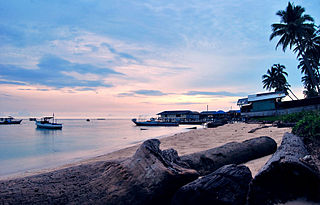Keretapi Tanah Melayu Berhad (KTMB) or Malayan Railway Limited, colloquially referred to simply as KTM, is the main rail operator in Peninsular Malaysia. The railway system dates back to the British colonial era, when it was first built to transport tin. Previously known as the Federated Malay States Railways (FMSR) the Malayan Railway Administration (MRA), and the Malayan Railway, Keretapi Tanah Melayu acquired its current name in 1962. The organisation was corporatised in 1992, but remains wholly owned by the Malaysian government.

Ipoh is the capital city of the Malaysian state of Perak. Located by the Kinta River, it is nearly 200 km (120 mi) north of Kuala Lumpur and 150 km (93 mi) southeast of George Town in neighbouring Penang. As of the 2020 census Ipoh had a population of 759,952, making it the eighth-largest city in Malaysia by population.

East Java is a province of Indonesia located in the easternmost third of Java island. It has a land border only with the province of Central Java to the west; the Java Sea and the Indian Ocean border its northern and southern coasts, respectively, while the narrow Bali Strait to the east separates Java from Bali by around 2.29 kilometres (1.42 mi). Located in eastern Java, the province also includes the island of Madura, as well as the Kangean islands and other smaller island groups located further east and Masalembu archipelagos in the north. Its capital is Surabaya, the second largest city in Indonesia, a major industrial center and also a major business center. Banyuwangi is the largest regency in East Java and the largest on the island of Java.

The Gombak District is an administrative district located in the state of Selangor, Malaysia. The district was created on February 1, 1974, the same day when Kuala Lumpur was declared a Federal Territory. Until 1997, Rawang was the district capital; the capital has been moved to Bandar Baru Selayang. Gombak borders Kuala Lumpur to the southeast and the Genting Highlands to the east. Both Gombak and Kuala Lumpur, along with some other districts in Selangor, are situated within the Klang Valley. Other localities in Gombak district include Batu Arang, Kuang, Rawang, Kundang, Gombak Town, Selayang, Batu Caves and Hulu Kelang.

The Derawan Islands are in the province of East Kalimantan in Indonesia. They consist of 31 islands, most well known among these are the islands of Derawan, Kakaban, Maratua, and Sangalaki. There are also numerous submerged reefs and islets. They are located in the Sulawesi Sea, on the coastal shelf of East Kalimantan. The islands are part of the Berau Regency.

Ratu Boko or Ratu Boko Palace is an archaeological site in Java. Ratu Boko is located on a plateau, about three kilometres south of Prambanan temple complex in Yogyakarta, Indonesia. The original name of this site is still unclear, however the local inhabitants named this site after King Boko, the legendary king mentioned in Roro Jonggrang folklore. In Javanese, Ratu Boko means "Stork King".

Goa Gajah, or Elephant Cave, is located on the island of Bali near Ubud, in Indonesia. Built-in the 9th century, it served as a sanctuary.

Labuan Bajo is a fishing town located at the western end of the large island of Flores in the East Nusa Tenggara province of Indonesia. It is the capital of the West Manggarai Regency, one of the eight regencies which are the major administrative divisions of Flores. The name Labuan Bajo is taken from the large number of Bajo tribes that live on the coast.

Ogan Komering Ulu Regency is a regency of South Sumatra, Indonesia. It formerly covered an area of 10,408 km2 with a population of around 1,000,000 people; however on 18 December 2003 parts of this area were split off to form separate regencies of East Ogan Komering Ulu and South Ogan Komering Ulu; the residual regency area covers just 4,797.06 km2 and had a population of 324,045 at the 2010 Census and 367,603 at the 2020 Census; the official estimate as at mid 2023 was 383,608. The administrative centre is the town of Baturaja.

Maros Regency is a regency of South Sulawesi province of Indonesia. It covers an area of 1,619.12 sq.km, and had a population of 319,002 at the 2010 Census and 391,774 at the Census of 2020. The official population estimate for mid-2023 was 407,920 according the Province's official estimates but only 389,277 according to the Regency's official estimates. Almost all of the regency lies within the official metropolitan area of the city of Makassar. The administrative centre of the regency is the town of Maros.

The KTM Batu Caves–Pulau Sebang Line, formerly known as the Seremban Line is one of the three KTM Komuter Central Sector lines provided by Keretapi Tanah Melayu. Its electric trains run between Batu Caves and Pulau Sebang/Tampin. Prior to 15 December 2015, the northern terminus of this line was Rawang.

Pindul Cave is a cave formed by karst with underground river located about 7 kilometres south of the city centre Wonosari, Gunung Kidul. Gua Pindul is known for the cave tubing that visitors can do and is done with tires that float above the underground river inside the cave, this activity known as cave tubing. There are gaps above the cave that can be passed as a pathway to enter vertically.
Lokale Cave is a cave in Papua, Indonesia. The cave is in the village Lokale Woslimo, Baliem Valley, Jayawijaya, Papua.

Pancuran Tujuh is a hot spring located on the slopes of Mount Slamet in Baturraden District, Banyumas, Central Java. Discovered, according to local legend, by a Muslim missionary known as Mbah Atas Angin, the hot spring and its sulfuric waters are considered to have healing properties.

Shrimp curry, also known as prawn curry, is a typical curry dish of Burmese cuisine, Indonesian cuisine in Indonesia, Indo-Portuguese cuisine in India (Goa) and Portugal, Mozambican cuisine in Mozambique and Thai cuisine in Thailand (Phuket).

Pura Goa Lawah is a Balinese Hindu temple or a pura located in Klungkung, Bali, Indonesia. Pura Goa Lawah is often included among the Sad Kahyangan Jagad, or the "six sanctuaries of the world", the six holiest places of worship on Bali. Pura Goa Lawah is noted for being built around the opening of a cave which is inhabited by bats, hence its name, the Goa Lawah or "bat cave".

Gua Lowo is a cave which is located at Watuagung, Watulimo sub-district of Trenggalek Regency, East Java in Indonesia. Gua Lowo is an Indonesian word, which means bat's cave. There are no other fauna except bats in this cave. The cave is about 5 kilometers long, though only 859 meters of the cave is accessible. Based on statements from cave experts, Mr. Gilbert Manthovani and Dr. Robert K Kho in 1984, Gua Lowo is the longest natural cave in Southeast Asia.
The Simpang-kanan River is a river in southern Sumatra, Indonesia, about 600 km northwest of the capital Jakarta. It is a tributary of the Rawas River.

Museum Angkut is a transport museum located in Batu, East Java, Indonesia, and located on the hillside of Mount Panderman, part of Mount Kawi-Butak. The museum has more than 300 collections of types of traditional to modern transportation. The museum is divided into several zones decorated with the background of building models from the continents of Asia, Europe to America. Especially in the European Zone, it's set by 1800-1900s French-style with various vintage European cars. Museum Angkut is the first all-type mode of transportation museum in Indonesia and Southeast Asia.

Cave diving is underwater diving in water-filled caves. The equipment used varies depending on the circumstances, and ranges from breath hold to surface supplied, but almost all cave diving is done using scuba equipment, often in specialised configurations with redundancies such as sidemount or backmounted twinset. Recreational cave diving is generally considered to be a type of technical diving due to the lack of a free surface during large parts of the dive, and often involves planned decompression stops. A distinction is made by recreational diver training agencies between cave diving and cavern diving, where cavern diving is deemed to be diving in those parts of a cave where the exit to open water can be seen by natural light. An arbitrary distance limit to the open water surface may also be specified. Despite the risks, water-filled caves attract scuba divers, cavers, and speleologists due to their often unexplored nature, and present divers with a technical diving challenge.
















